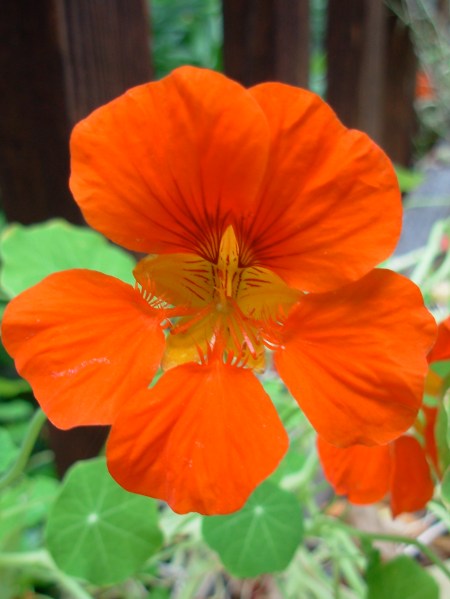I love nasturtiums and this summer I had a real cascade of them tumbling over the deck boxes in their bright colors and peppery scents. My daughter and I went to weed them the other day and noticed that many had gone to seed and still many others had dropped their seeds on the deck. We gathered the seeds excitedly, figuring that since they were intact and recognizable as the nasturtium seeds we’d planted before, we should be able to save these for planting in the future.
After all, what better way for kids to learn about the process of seeds becoming plants than to collect, save, plant and grow their own seeds?
I since found a couple of wonderful resources about seed saving.
Mr. Brown Thumb has a lot of great information about collecting nasturtium seeds, complete with a video. He says that larger seeds are best, and that it doesn’t matter if the seeds are brown or green. This is good news because I found plenty of both.
About.com has a lot of great information about seed saving in general, including which other seeds are good candidates for saving:
Methods and Timing for Saving Seeds
Always choose the best quality plants, flowers, fruits and vegetables from which to save seeds. Look for disease resistance, vigor, great flavor and productivity. Next year’s plants will only be as good as this year’s seed. Harvest seeds either:
- When the seed pods have dried on the plant (flowers, beans, broccoli, lettuce…)Keep an eye on the pods as they start to brown. Most seed pods will open and disperse on their own. You can catch seed by placing small bags over the seed heads when they look ready to pop or by pulling the plant just before completely dry and storing upside down in a paper bag.
Storing Saved Seed
- Make sure the seed is completely dry, or it will rot or mold in storage
- Remove as much of the chaff as possible
- Store in a paper envelope, labeled with the variety and year
- Place the envelopes into an air tight container, such as a canning jar
- Store in a cool, dark, dry place
- Stored seed is best used the following year
What Seeds Can Be Saved?
Open Pollinated or heirloom, self-pollinated plants are the only varieties that will grow true from seed, meaning the seedlings will be exactly like the parents. These are the seeds worth saving.
Self-pollinated plants are the easiest to save and include: Beans, Chicory, Endive, Lettuce, Peas, Tomatoes. You can also save many heirloom flower seeds such as: cleome, foxgloves, hollyhock, nasturtium, sweet pea, and zinnia.
I dried my seeds on this old bulb storage crate from the Netherlands. It’s come in handy for all kinds of drying projects.
I stored my seeds according to the above guidelines. I’ll plant them next year and will let you know how they do.
Photos by Susan Sachs Lipman






























Pingback: A Neighborhood Walk Turns into a Hike to the Muir Woods, Thanks to New Book - Slow Family
Pingback: Top 10 Ways to Learn in Your Own Backyard - Slow Family
Pingback: 10 Ways to Learn in Your Own Backyard - Parents Place